A new tank for the cuirassiers.
The famous Napoleonic cuirassiers, which still are displayed in official events and on 14th of july parade as republican horse guards, had their traditions shattered during world war one, when it became obvious that the cavalry was obsolote in this new kind of stalemate which prevailed on the western front. When the firt tanks appeared in 1917, new tactics quickly led to give this new kind of instrument to the cavalry corp, leaving their horses for these new mechanized beasts, but almost similiar duties.Since then, the French, as well as the British and Soviets, always made the distinguo between two kind of tanks, the infantry and cavalry ones (as well as the heavy breaktrhough tank, in french "char de rupture" as the FMC 2c). Plans for a new cavalry tank, which was to replace obsolete models, came as soon as 1931, revised on 26 June 1934, which a new, heavier model, capable of resisting any antitank gun at that time. The task was given to the St Ouen Societe d'Outillage Mecanique et d'Usinage d'Artillerie (SOMUA)...
Design of the S35.
The hull was made of four parts, and the turret was a solid piece of cast iron, as well the hull, with max thickness around 47 and 40 mm respectively. The turret was derived of the B1 heavy tank model, but with an enlarged turret ring, allowing both the tank commander and the gun operator to be in at the same time. The medium-barrel SA-35 47 mm was a common issue, it was efficient against most german and soviet tanks at the time, using a provision of 90 AP and 28 HE shots. There was also a coaxial 7.5 Reibel machine gun with 2250 rounds. Radio was scheduled to equip all S35 units, but as the ER28 production never reach the required level and only one tank of five were equipped, despite the fact that many of them incuded an antenna.Engineer Eugene Brillé worked on the suspensions, inspired by the one used on the Skoda LT35, with eight road wheels on four bogies with leaf spring and a large torsion wheel. The initial tracks were 75 mm wide, with 144 links, later 103 with enlarged pieces. The rear engine was side by side with two self-feeding fuel tanks, and the crew was protected by a thick firewall bulkhead. The V8 Somua designed by engineer Javier-Sabin developed about 200 bhp and used a double filling tank system which sometimes caused some problems.
Production.
The preliminary design was ready in september, definitive plans in october, just as the construction began. The first prototype was ready in april 1935, undergoing successful trials until august, and gaining an order, so the model was named after its year of production. But the official denomination was AMC (AutoMitrailleuse de Combat). A preserie model AC4 was to be tested until january 1936 with the new APX1 Turret, and then production was scheduled to start in march.However the S35 has several flaws, the first of which was a common issue among french tanks: A overloaded commander, and at the same time, a hatchless turret (mostly adopted for budgetary reasons) which caused the same commander to be unprotected, completely outside the turret. The other flaws was maintenance: The cast iron modules didn't facilitate any access to the suspension, which was uneasy and time-consuming. Also the cost per unit was high, and only a limited numbers of this excellent medium tank were ever produced. On the first of september, 1939, 246 had been delivered, and only 288 were in service by may 1940, but 430 were built in all in june 1940. Production was halted for the more advanced SOMUA S40.
The Somuas S35 and S40 in action :
By may 1940, the bulk of the S40 force was allocated to the first army deployed in belgium in the 1st, 2nd and 3rd DLM (Division Légère mécanique). Because of the lack of support and a weak constitution compared to the german panzerdivisions, these units performed as they could, with high losses, but with some successes, most of them beeing advocated to the S35 armor and firepower. The battle of Hannut (may 12-14), the largest tank battle in 1940, occured between six armoured divisions, a clash of nearly 1700 tanks and armoured vehicles. Despite tactical victories along strongpoints, it was a strategical failure, the Germans systematically outmanoeuvered the French, gaining local superior firepower, with excellent communication and support. At the same time, french tactics "from the book" proved obsolete.In another occasion, in may, 17, Colonel De Gaulle 4th DCR, comprising many S35 as well as Hotchkiss, B1 and Renault tanks, tried to stop the german advance at Laon and Montcornet. Although they gained momentum and local successes, even making hundreds of German prisoners, the luftwaffe and German flak 88 mm quickly deployed and used as antitank battery for the first time in the war, crushed any further progresses. Many S35 of the remaining forces fought to prevent three german panzerdivisions form approaching Dunkirk. They were destroyed or ultimately abandoned, deprived of ammunition and fuel. Later in june, other S35 fought in Weygand's so-called "strongpoints", which were outmanoeuvered once again, hammered by artillery and the Luftwaffe, and eventually forced to surrender one by one.
In february 1941, most of these fought with the Panzerbrigade 100. Eventually this unit was renamed 211 Panzerabteilung and sent to Finland, fighting on the eastern front. However they were outclassed by Soviet KV1 and T34. Others formed suppletive unit for re-organized Panzerdivisions, for training and transport (without their turret or with an open superstructure), and for police duties. Some fought the resistance on many occasions, and some were hastily sent to Normandy, in june 1944 (Panzer Ersatz Abteilung 100 and Panzer Abteilung 206).
Others were sent in Yugoslavia, fighting the partisans. Many dismounted turrets were also allocated to German armoured trains, which served in all European theaters. Axis gained also some S35, the biggest user beeing Italy with 32 tanks. They fought in Italy itself, acting as a reserve. In december 1944, a single German unit was still equipped with an handful of S35. But they were then hopelessly outdated.
Specs sheet : SOMUA S-35 |
|
| Dimensions (l-w-h): | 5,38 x 2,12 x 2,62 m |
| Total weight, battle ready : | 19,5 Tons |
| Crew : | 3 |
| Propulsion : | Somua V8 petrol 200hp |
| Speed (road/off road): | 40/32.2 kph |
| Range (road/off road)-fuel : | 230/130 km -510L |
| Armament : | 47mm SA35 gun & 2x Reibel 7,5mm Mg |
| Armour : | From 20 to 48mm |
| Total production | 430 |
Somua S35 Gallery




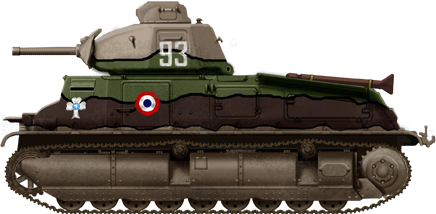
Second cavalry bataillon, first army of gen. Billotte, Battle of Hannut, 13-15 may 1940.
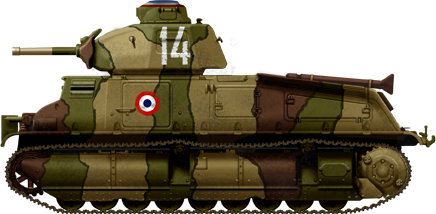
A 1937 manoeuvers regular S35 with the 4th cuirassiers, the first cavalry unit to receive Somuas.
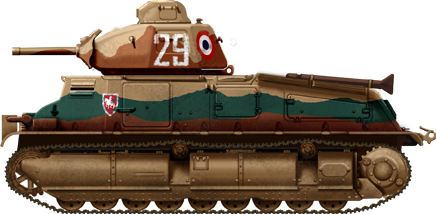
Somua of the 4th DCR (part of the 3th Cuirassiers), Montcornet counterattack on 17 may 1940, and which fought also at Crecy sur Seine and Laon.
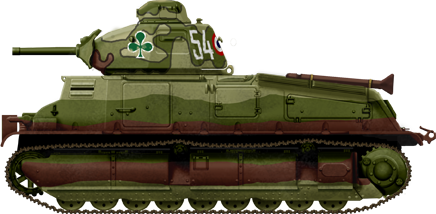
Somua of the 2th DLM which fought at Craonne, 14 may 1940.
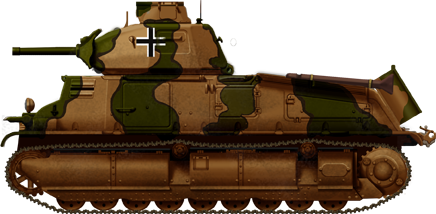
Panzerkampfwagen 35-S 739(f), 202th Panzer Abteilung, Balkans, march 1944.
Somua S-35 Links
Main article on Wikipedia
On Military Factory

WW2 Tanks




























WW2 tanks posters

All Tiger tanks liveries.

Panther liveries and variants

WW2 Armour - All tanks











Tanks aces and single tanks series

Find more there

Museums, Movies, Books & Games
The Tanks and Armor in pop culture
Tanks and armored vehicles in general are only really grasped when seen first person: The mass, the scale, it's all there. Explore also the way tanks were covered in the movie industry, in books and in video games.Movies:
Best tanks movie on warhistoryonline.com
On imdb.com
On bestsimilar.com/
miltours.com
liveabout.com/
watchmojo.com
Video Games:
pcgamesn.com
historyhit.com
levvvel.com
vg247.com/best-tank-games
mmobomb.com/
alienwarearena.com

